Alt Syscalls for Windows 11
Keep Calm and Thunk On!
Intro
You can check this project out on GitHub! To help you find exact code samples see the below links:
Alternate Syscalls have been documented previously for Windows 10, starting with the research by 0xcpu, and then a nice write up by Xacone. There is a problem however; the mechanisms outlined by 0xcpu don’t work on Windows 11.
With this, I started my own research into the changes in the Windows 11 Kernel that Microsoft have done for alternate syscalls; its fair to say they have completely reworked the mechanism. I’ll start by saying, in my testing, PatchGuard does not monitor the structures used in this - if you find different, please let me know either by email (fluxsec@proton.me), or at X - @0xfluxsec. I have tested this under conditions I believe HyperGuard should be working under, using ssde to load my driver with VBS and Secure Boot enabled, and there were no crashes, so this leads me to believe it is also HyperGuard resistant - that said, I encourage the community to test this and if you come to a different outcome, I would welcome the feedback.
Thanks to some testing by Xacone, we now know that HVCI prevents writing to the PspServiceDescriptorGroupTable structure; so that is one limitation of this technique. Should
there be any further updates to the limitations of this, I will update my posts respectively.
The code samples in this report are in Rust (sorry C people), I may make a C port if it’s a popular request.
What are alt syscalls
Alternate Syscalls (or Alt Syscalls) are a fully undocumented feature of the Windows Kernel, which allows a callback routine to receive a copy of trap data for a syscall in the kernel. It has been commented, this is likely an internal only feature Microsoft planned to use in Windows Defender.
The use of Alt Syscalls in the kernel is a massive benefit for AntiVirus or Endpoint Detection and Response software, the ability to hook system call’s has not been possible for a long time thanks to PatchGuard which monitors alteration to key internal structures, such as the System Service Dispatch Table, or the Nt* functions themselves implementing the logic.
As such, security vendors moved out of the kernel and hooked system call stubs in userland via a DLL. I have done this myself, you can check out my blog post on that here.
With the introduction of the undocumented Alt Syscalls in Windows 11, one could essentially get rid of the DLL hooks in userland on syscalls and move them into the kernel. Why would you want to do this? Techniques such as HellsGate (which I have written about here), and Halos Gate, can bypass these userland hooks. Whilst there will be technologies out there to try combat this (such as my Ghost Hunting technique), it is still, in 2025, an exploitable weakness of security products.
So, if we can monitor syscalls in the kernel - we do not need userland hooks.
Conversely a rootkit could utilise kernel syscall hooks to monitor operations on the system, but to be honest - they can get most of that data from Events Tracing for Windows, or other sources. I’m not entirely sure its worth the effort.
Reversing the kernel mechanism
To save duplication; I would recommend first reading Xacones write-up of Windows 10 AltSyscalls to see what the implementation there looked like, the author does a really good job of explaining. That will provide a background on some of what we discuss now.
Type differences
Before we go on; lets look at some new fields on the _EPROCESS:
The only new struct we make use of for this method, is SyscallProviderDispatchContext. This struct contains two fields, Level and Slot.
- Level: We never read / write to this; so I don’t know what its used for, I haven’t tried looking further.
- Slot: This field is an index, which must be less than 20, which indexes into an array we will look at later that would allow for multiple alt syscall providers. We will use slot 0, but I guess in theory these could be used if this becomes a public API in the future, or if Defender uses them.
The SyscallProvider field seems to be used for logging purposes, perhaps an identifier as to who the active provider is.
The system dispatch routine
For those not in the know, I am currently making my own EDR called Sanctum - this has turned into a full time hobby; and its basically my mechanism of learning more about Windows Internals and low level security. During that journey, I looked to implement AltSyscalls. I quickly discovered this wasn’t working in my Windows 11 VM, and raised an issue in Xacone’s EDR project.
I had discovered that the PsAltSystemCallHandlers array is not used in Windows 11, save for in the (still available) function PsRegisterAltSystemCallHandler.
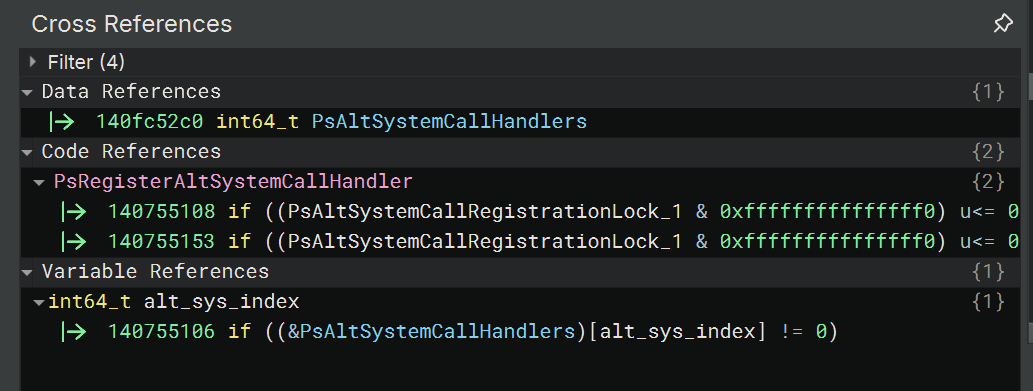
Hmm; this symbol was pivotal to the Alt Syscall technique in Windows 10. Alright - lets start from the beginning.
System Calls in Windows go through a set routine which eventually gets them into a function called: KiSystemServiceUser (in Binary Ninja you’ll have to view this as part of KiSystemService64 / KiSystemService).
We can see from the control flow graph of IDA, KiSystemServiceUser has a branch which checks first whether the Header union is flagged with data under DebugActive, and then whether the bit is set (0x24) for AltSyscall.
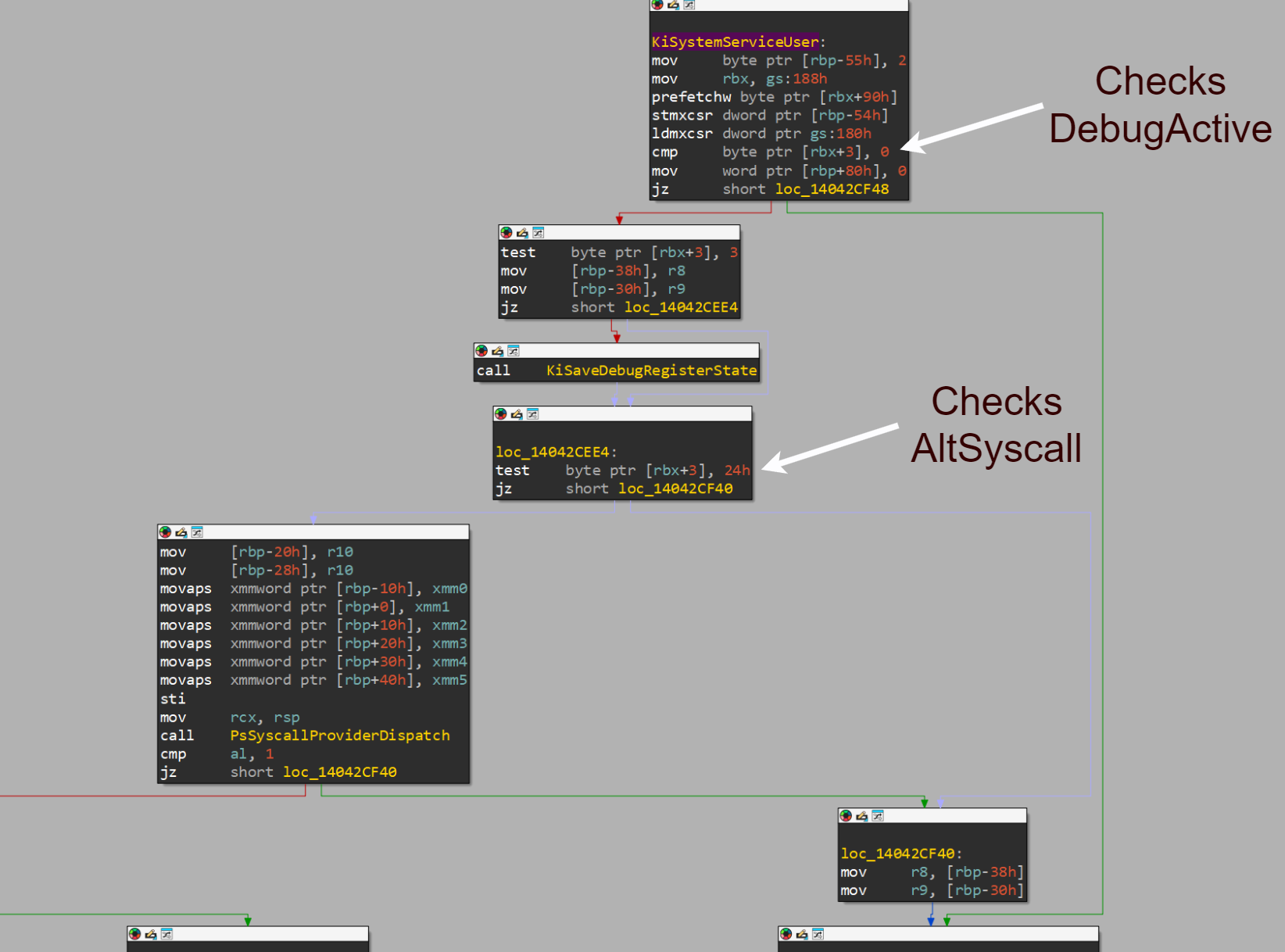
We can see, if the right bits are active then we will branch into calling PsSyscallProviderDispatch, passing in the KTRAP_FRAME as its argument.
PsSyscallProviderDispatch
N.b., we will look at this diagram again later; but I think it helps at this point whilst working through this section. These are the structs I landed on to enable alt syscalls:
This function (PsSyscallProviderDispatch) replaces the Windows 10 PsAltSystemCallDispatch that was used in 0xcpu’s technique, and its now more complex.
First, again, the function checks whether the DebugActive flag is enabled, and checks that the Slot field mentioned above is < 20.

It then loads the PspServiceDescriptorGroupTable symbol. We can infer the size of each entry from the first part of the operations here, the size of each entry is 0x18 bytes in length. It’s easier to see this with the decompilation view:

There are a lot of parallels and patterns here which you’ll find in normal syscall dispatch around calculating relative addresses in the registers. The below took me a while to understand ^^.
The function gets the SSN (System Service Number) from the KTRAP_FRAME, and checks it against some value starting at the PspServiceDescriptorGroupTable table entry we got (i.e. the first field). This field is the count of SSN’s we provide for (or, more correctly, the capacity). Whilst testing, this was a large source of instability, if the SSN is less than the count of SSNs the table contains, it will just return out of the function.
It reaches into a table to grab the base address of the driver; and then calculates the address of the callback routine based off of an offset. This table is accessed by index of the SSN, allowing separate callback functions if so desired. With thanks to @sixtyvividtails and @gal_kristal for pointing out my previous method of doing this (allocating RWX memory & writing thunks) was an extra, unnecessary step. Well spotted both, so thank you for the feedback! As pointed out by @gal_kristal, this is consistent with how normal syscall dispatch works.
It then extracts some flags out of the table entry; these determine whether we make the call to our Alt Syscall callback routine via PspSyscallProviderServiceDispatch or via PspSyscallProviderServiceDispatchGeneric. I have only gone the PspSyscallProviderServiceDispatch route, so if you wish to try get this working for PspSyscallProviderServiceDispatch feel free! Do note however, if you try set a flag for that route with the same callback I have used, you will get a bug check, unfortunately my callback prototype is not valid for PspSyscallProviderServiceDispatch.
To make it a little clearer:
- Fast path (chosen when
(flags & 0x10) == 0): callsPspSyscallProviderServiceDispatchdirectly. - Generic path (when
(flags & 0x10) != 0): callsPspSyscallProviderServiceDispatchGeneric, and the low bits (0–3) specify how many QWORDs to copy (the kernel converts that into a byte‐count withflags << 3).

PspSyscallProviderServiceDispatchGeneric
Assuming we now take the branch to PspSyscallProviderServiceDispatchGeneric, it takes the encoded QWORD count mentioned above. I haven’t actually found a need for this, I lost the variable whilst debugging it - so devised an alternate approach (see callback function section). This ‘metadata’ integer is how many QWORDs you want to copy of stack arguments (i.e. arguments 5 and onwards). You can see its implementation here in PspCaptureSystemServiceInMemoryArgs:
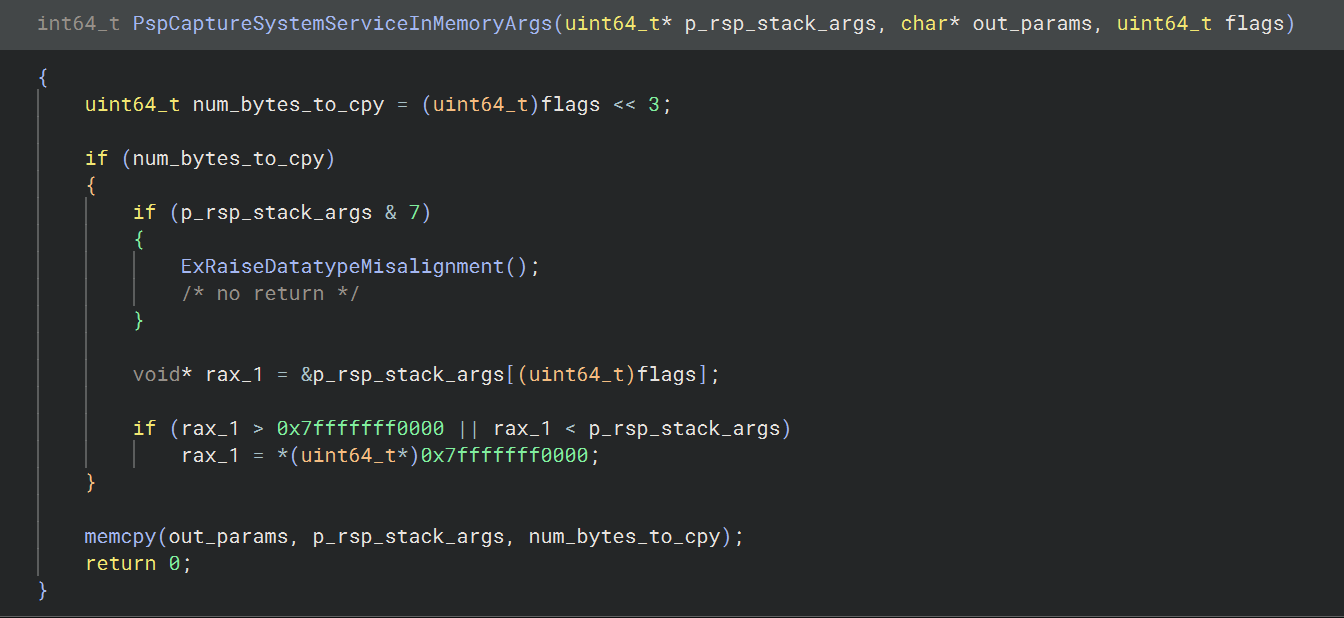
Nothing particularly spectacular happens in here, save for dispatching our callback:
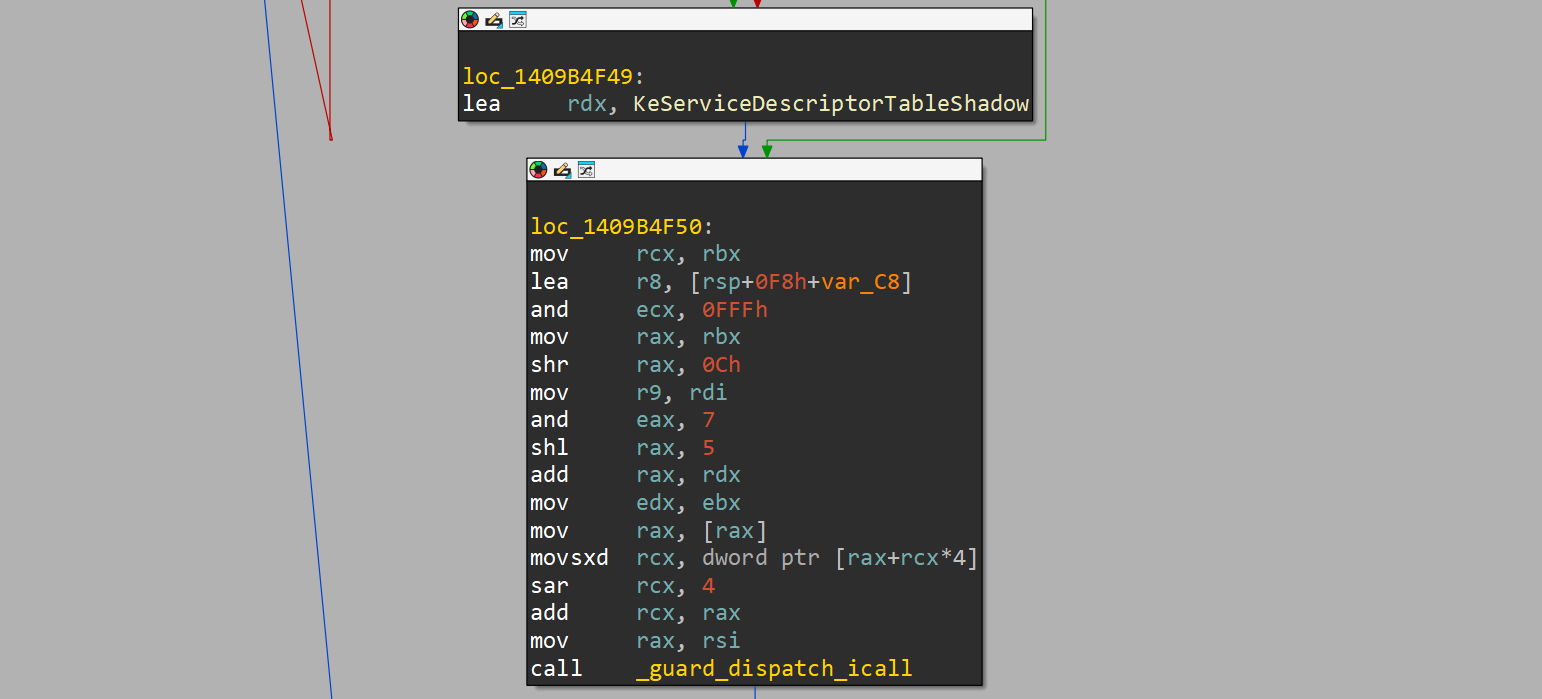
I will admit; I don’t have a clue how _guard_dispatch_icall works, if anyone wants to educate me, please message me! Looking at it in the debugger however, it is clear to see what is going on, it makes a call to KscpCfgDispatchUserCallTargetEsSmep:

Which in turn looks like:

This is a jmp rax instruction! Whilst working through this; it threw me for a while. The kernel function calculates the address of our callback function based on relative offsets + the driver base address we pack into some structures (see my code below). The function puts our callback address into eax, and we jump there!
If we examine the memory at 0FFFFF8011C118740h, its my callback function!
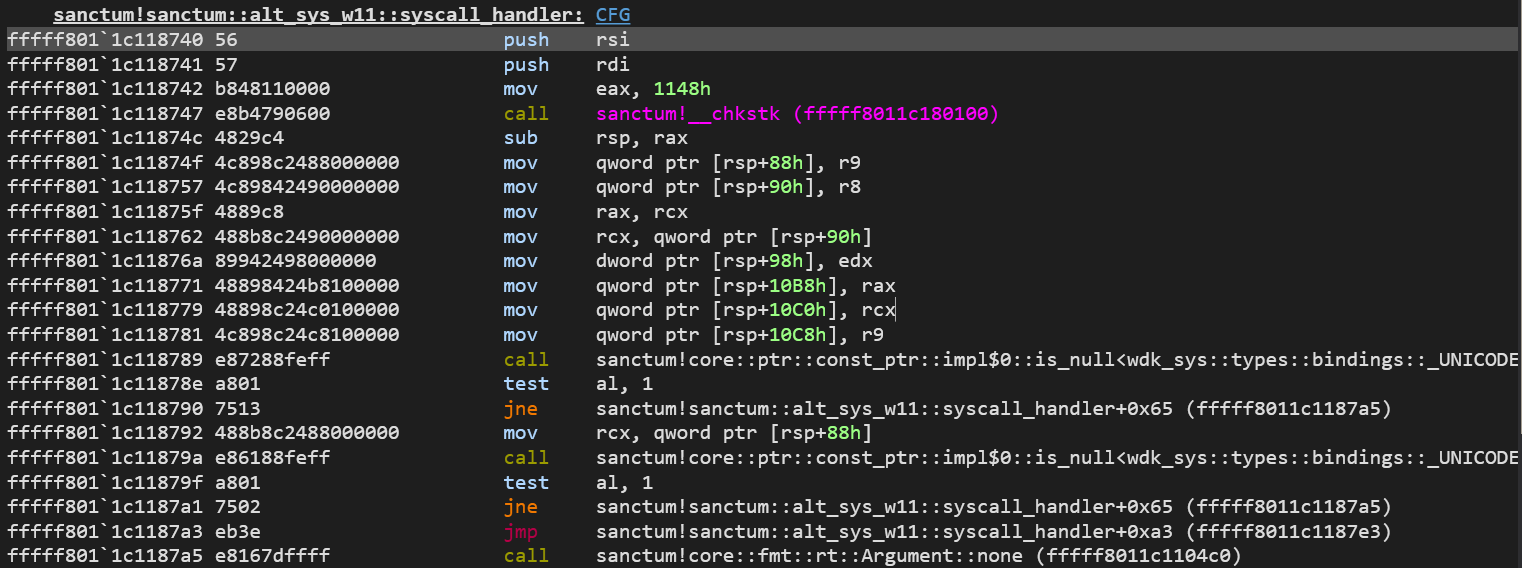
The callback routine
With understanding the general mechanisms of the new Windows 11 Alt Syscall dispatch routines, we can now look at the callback! Again, this took a little while to figure out, debugging and tracking registers and the stack, but the callback routine looks as follows (in Rust, again apologies C people!).
It’s worth noting also, we have to return 1 from this function (see below IDA graph):

The arguments are explained in the function comments:
/// The callback routine which we control to run when a system call is dispatched via my alt syscall technique.
///
/// # Args:
/// - `p_nt_function`: A function pointer to the real Nt* dispatch function (e.g. NtOpenProcess)
/// - `ssn`: The System Service Number of the syscall
/// - `args_base`: The base address of the args passed into the original syscall rcx, rdx, r8 and r9
/// - `p3_home`: The address of `P3Home` of the _KTRAP_FRAME
///
/// # Note:
/// We can use the `p3_home` arg that is passed into this callback to calculate the actual address of the
/// `KTRAP_FRAME`, where we can get the address of the stack pointer, that we can use to gather any additional
/// arguments which were passed into the syscall.
///
/// # Safety
/// This function is **NOT** compatible with the `PspSyscallProviderServiceDispatch` branch of alt syscalls, it
/// **WILL** result in a bug check in that instance. This can only be used with
/// `PspSyscallProviderServiceDispatchGeneric`.
pub unsafe extern "system" fn syscall_handler(
_p_nt_function: c_void,
ssn: u32,
args_base: *const c_void,
p3_home: *const c_void,
) -> i32 {
// ..
}
Without re-explaining what I have written there, the 3 important args are the last 3. We have the SSN in rdx, the base address of 0x20 bytes for the first 4 arguments passed into the Nt* function by the syscall caller, you can get these just with some pointer arithmetic.
p3_home is where things get interesting. As I alluded to above, I couldn’t figure out where the buffer we pass to PspCaptureSystemServiceInMemoryArgs went (on reflection maybe its arg 5 on the current stack), so I took an alternative approach after realising that the 4th param is part of the KTRAP_FRAME. With some pointer arithmetic, we can get the rsp of the syscall caller, and grab the arguments that way :).
Seeing as through I’m building an EDR, I wanted to monitor syscalls for common process injection:
- NtOpenProcess
- NtAllocateVirtualMemory
- NtWriteVirtualMemory
- NtCreateThreadEx
We can match (for C people, thats a switch) on the SSN, monitoring for the numbers to which the syscall relates. You can also see the pointer arithmetic used to get the arguments from the callee (only demo’d for NtAllocateVirtualMemory):
pub unsafe extern "system" fn syscall_handler(
_p_nt_function: c_void,
ssn: u32,
args_base: *const c_void,
p3_home: *const c_void,
) -> i32 {
if args_base.is_null() || p3_home.is_null() {
println!("[sanctum] [-] Args base or arg4 was null??");
return 1;
}
let k_trap = unsafe { p3_home.sub(0x10) } as *const KTRAP_FRAME;
if k_trap.is_null() {
println!("[sanctum] [-] KTRAP_FRAME was null");
return 1;
}
const ARG_5_STACK_OFFSET: usize = 0x28;
let k_trap = &unsafe { *k_trap };
let rsp = k_trap.Rsp as *const c_void;
let rcx = unsafe { *(args_base as *const _ as *const usize) } as usize;
match ssn {
0x18 => {
let rcx_handle = unsafe {
*(args_base as *const *const c_void)
};
let rdx_base_addr = unsafe {
*(args_base.add(0x8) as *const *const c_void)
};
let r8_zero_bit = unsafe {
*(args_base.add(0x10) as *const *const usize)
};
let r9_sz = unsafe {
**(args_base.add(0x18) as *const *const usize)
};
let alloc_type = unsafe { *(rsp.add(ARG_5_STACK_OFFSET) as *const _ as *const u32) } as u32;
let protect = unsafe { *(rsp.add(ARG_5_STACK_OFFSET + 8) as *const _ as *const u32) } as u32;
println!("[VirtualAllocEx] [i] handle: {:p}, base: {:p}, zero bit: {:p}, Size: {}, alloc_type: {:#x}, protect: {:#x}", rcx_handle, rdx_base_addr, r8_zero_bit, r9_sz, alloc_type, protect);
},
0x26 => {
println!("[NtOpenProcess] [i] Hook. SSN {:#x}, rcx as usize: {}. Stack ptr: {:p}", ssn, rcx, rsp);
},
0x3a => {
println!("[Write virtual memory] [i] Hook. SSN {:#x}, rcx as usize: {}. Stack ptr: {:p}", ssn, rcx, rsp);
},
0x4e => {
println!("[create thread] [i] Hook. SSN {:#x}, rcx as usize: {}. Stack ptr: {:p}", ssn, rcx, rsp);
},
0xc9 => {
println!("[create thread ex] [i] Hook. SSN {:#x}, rcx as usize: {}. Stack ptr: {:p}", ssn, rcx, rsp);
},
_ => {
// println!("SSN: {:#x}", ssn);
},
}
1
}
As you can see, it works! These are the prints that you can see above when running “malware.exe” which performs some basic process injection.

Initialising the structures
Now; onto the structures we need to work with. The definitions I landed on:
#[repr(C)]
pub struct PspServiceDescriptorGroupTable {
rows: [PspServiceDescriptorRow; 0x20],
}
#[repr(C)]
#[derive(Copy, Clone)]
struct PspServiceDescriptorRow {
driver_base: *const c_void,
ssn_dispatch_table: *const AltSyscallDispatchTable,
_reserved: *const c_void,
}
#[repr(C)]
struct PspSyscallProviderDispatchContext {
level: u32,
slot: u32,
}
#[repr(C)]
struct AltSyscallDispatchTable {
pub count: u64,
pub descriptors: [u32; SSN_COUNT],
}
For the Rust uninitiated, #[repr( C )] is an attribute that tells the compiler to adhere to C’s memory layout.
To visualise these structs:
So, we now need to populate these with data. I’ve provided some thorough comments in the below code, but in general handfuls:
- Get our callback routines address as a function pointer.
- Fill the ‘Alt Syscall Dispatch Table’ with a count (capacity) of the max SSN’s we are providing for, and fill the descriptor array with zeros.
- Calculate the offset of the callback routine from the base address of the driver; this will give us a RVA of the function.
- Do an additional check that the offset is not > u32::MAX - otherwise we risk some integer truncation, giving us a bad offset.
- For each descriptor, shift in the calculated offset from step 3, followed by the flags to get us to the Generic dispatch routine + number of QWORDs to copy from the callee’s stack.
- Leak the table so the memory is consistent (for Rust’s RAII - I’ll fix the memory leak later).
- Resolve the PspServiceDescriptorGroupTable symbol.
- Write a new Row for the PspServiceDescriptorGroupTable which:
- Stores the base address of the driver.
- Stores the address of the descriptor table.
- Walk all processes to enable the relevant bits so running processes use our alt syscall :).
pub fn enable(driver: &mut DRIVER_OBJECT) {
// How many stack args we want to memcpy; I use my own method to get these..
const NUM_QWORD_STACK_ARGS_TO_CPY: u32 = 0x0;
// These flags ensure we go the PspSyscallProviderServiceDispatchGeneric route
const GENERIC_PATH_FLAGS: u32 = 0x10;
// Enforce the SLOT_ID rules at compile time
const _: () = assert!(SLOT_ID <= 20, "SLOT_ID for alt syscalls cannot be > 20");
//
// Get the base address of the driver, so that we can bit shift in the RVA of the callback.
//
let driver_base = match get_module_base_and_sz("sanctum.sys") {
Ok(info) => info.base_address,
Err(e) => {
println!("[-] Could not get base address of driver. {:?}", e);
return;
},
};
//
// Now build the 'mini dispatch table': one per descriptor. Each index of the descriptor contains a relative pointer from the driver base
// address to the callback function.
//
// low–4 bits = metadata (0x10 = generic path + N args to capture via a later memcpy),
// high bits = descriptor index<<4.
//
// Setting FLAGS |= (METADATA & 0xF) means generic path, capture N args
//
let callback_address = syscall_handler as usize;
let metadata_table = Box::new(AltSyscallDispatchTable {
count: SSN_COUNT as _,
descriptors: [0; SSN_COUNT],
});
// Leak the box so that we don't (for now) have to manage the memory; yes, this is a memory leak in the kernel, I'll fix it later.
let p_metadata_table = Box::leak(metadata_table) as *const AltSyscallDispatchTable;
let rva_offset_callback = callback_address - driver_base as usize;
// SAFETY: Check the offset size will fit into a u32
if rva_offset_callback > u32::MAX as _ {
println!("[sanctum] [-] OFfset calculation very wrong? Offset: {:#x}", rva_offset_callback);
return;
}
for i in 0..SSN_COUNT {
unsafe { &mut *(p_metadata_table as *mut AltSyscallDispatchTable)}.descriptors[i] = ((rva_offset_callback as u32) << 4) | (GENERIC_PATH_FLAGS | (NUM_QWORD_STACK_ARGS_TO_CPY & 0xF));
}
println!(
"[sanctum] [+] Address of the alt syscalls metadata table: {:p}",
p_metadata_table
);
// Get the address of PspServiceDescriptorGroupTable from the kernel by doing some pattern matching; I don't believe
// we can link to the symbol.
let kernel_service_descriptor_table = match lookup_global_table_address(driver) {
Ok(t) => t as *mut PspServiceDescriptorGroupTable,
Err(_) => {
println!("[sanctum] failed to find kernel table");
return;
}
};
//
// Insert a new row at index 0 in the PspServiceDescriptorGroupTable; in theory, if these were already occupied by other software
// using alt syscalls, we would want to find an unoccupied slot.
// This is what the Slot field relates to on the _PSP_SYSCALL_PROVIDER_DISPATCH_CONTEXT of _EPROCESS - essentially an index into which
// syscall provider to use.
//
let new_row = PspServiceDescriptorRow {
driver_base,
ssn_dispatch_table: p_metadata_table,
_reserved: core::ptr::null(),
};
// Write it to the table
unsafe {
(*kernel_service_descriptor_table).rows[SLOT_ID as usize] = new_row;
}
// Enumerate all active processes and threads, and enable the relevant bits so that the alt syscall 'machine' can work :)
Self::walk_active_processes_and_set_bits(AltSyscallStatus::Enable);
}
Setting the thread and process bits
There are two functions responsible for setting (and unsetting) the required bits for the alt syscalls on threads & processes. The only difference here really from Windows 10 is setting the Slot field on the _EPROCESS.
pub fn configure_thread_for_alt_syscalls(p_k_thread: PKTHREAD, status: AltSyscallStatus) {
if p_k_thread.is_null() {
return;
}
// Check if is pico process, if it is, we don't want to mess with it, as I haven't spent time reversing the branch
// for this in PsSyscallProviderDispatch.
let dispatch_hdr = unsafe { &mut *(p_k_thread as *mut DISPATCHER_HEADER) };
if unsafe {
dispatch_hdr
.__bindgen_anon_1
.__bindgen_anon_6
.__bindgen_anon_2
.DebugActive
& 4
} == 4
{
return;
}
// Assuming now we are not a pico-process; set / unset the AltSyscall bit on the ETHREAD depending upon
// the `status` argument to this function.
unsafe {
match status {
AltSyscallStatus::Enable => {
dispatch_hdr
.__bindgen_anon_1
.__bindgen_anon_6
.__bindgen_anon_2
.DebugActive |= 0x20
}
AltSyscallStatus::Disable => {
dispatch_hdr
.__bindgen_anon_1
.__bindgen_anon_6
.__bindgen_anon_2
.DebugActive &= !0x20
}
}
}
}
pub fn configure_process_for_alt_syscalls(p_k_thread: PKTHREAD) {
let p_eprocess = unsafe { IoThreadToProcess(p_k_thread as PETHREAD) } as *mut u8;
let syscall_provider_dispatch_ctx: &mut PspSyscallProviderDispatchContext =
if !p_eprocess.is_null() {
unsafe {
let addr = p_eprocess.add(0x7d0) as *mut PspSyscallProviderDispatchContext;
&mut *addr
}
} else {
return;
};
// Set slot id
syscall_provider_dispatch_ctx.slot = SLOT_ID;
}
Monitoring processes
As mentioned, we need to enable this for all processes. This is as simple as enumerating each _EPROCESS and _ETHREAD and setting the bits. We also use the kernel callback routine for new thread creation to set the bits on future threads. We don’t need to do this on process creation, as no syscall will happen until a thread is run - so, we can just use that as a choke-point. You can see me call the function walk_active_processes_and_set_bits above, taking in an enum.
This is as follows. Note: The wdk for Rust didn’t define the _EPROCESS and _ETHREAD structs, so I’ve used some constant offsets to the fields.
This is bad practice, and it will only work until Microsoft change the layout of the structures. But it works for now.
/// Walk all processes and threads, and set the bits on the process & thread to either enable or disable the
/// alt syscall method.
///
/// # Args:
/// - `status`: Whether you wish to enable, or disable the feature
///
/// # Note:
/// This function is specifically crafted for W11 24H2; to generalise in the future after POC
fn walk_active_processes_and_set_bits(status: AltSyscallStatus) {
// Offsets in bytes for Win11 24H2
const ACTIVE_PROCESS_LINKS_OFFSET: usize = 0x1d8;
const UNIQUE_PROCESS_ID_OFFSET: usize = 0x1d0;
const THREAD_LIST_HEAD_OFFSET: usize = 0x370;
const THREAD_LIST_ENTRY_OFFSET: usize = 0x578;
let current_process = unsafe { IoGetCurrentProcess() };
if current_process.is_null() {
println!("[sanctum] [-] current_process was NULL");
return;
}
// Get the starting head for the list
let head = unsafe { (current_process as *mut u8).add(ACTIVE_PROCESS_LINKS_OFFSET) }
as *mut LIST_ENTRY;
let mut entry = unsafe { (*head).Flink };
while entry != head {
// Get the record for the _EPROCESS
let p_e_process =
unsafe { (entry as *mut u8).sub(ACTIVE_PROCESS_LINKS_OFFSET) } as *mut _EPROCESS;
let pid = unsafe {
let p = (p_e_process as *mut u8).add(UNIQUE_PROCESS_ID_OFFSET) as *const usize;
*p
};
// Skip the Idle process (PID 0) as there are no threads present and it gave a null ptr deref
if pid == 0 {
entry = unsafe { (*entry).Flink };
continue;
}
// Walk threads
let thread_head =
unsafe { (p_e_process as *mut u8).add(THREAD_LIST_HEAD_OFFSET) } as *mut LIST_ENTRY;
let mut thread_entry = unsafe { (*thread_head).Flink };
while thread_entry != thread_head {
// Here we have each thread, we can now go and set the bit on the thread and process to make
// alt syscalls work
let p_k_thread = unsafe { (thread_entry as *mut u8).sub(THREAD_LIST_ENTRY_OFFSET) }
as *mut _KTHREAD;
Self::configure_thread_for_alt_syscalls(p_k_thread, status);
Self::configure_process_for_alt_syscalls(p_k_thread);
thread_entry = unsafe { (*thread_entry).Flink };
}
// Move on to the next process
entry = unsafe { (*entry).Flink };
}
}
HyperGuard
As mentioned earlier, I haven’t yet tested this against HyperGuard. However - I suspect HG doesn’t currently monitor the PspServiceDescriptorGroupTable structure, as I don’t think the new mechanisms are implemented in the Secure Kernel.
When starting the research, one thing I omitted above, was coming across a number of functions which follow the naming convention (I cant wildcard either side because of how I format my blog): SyscallProvider:
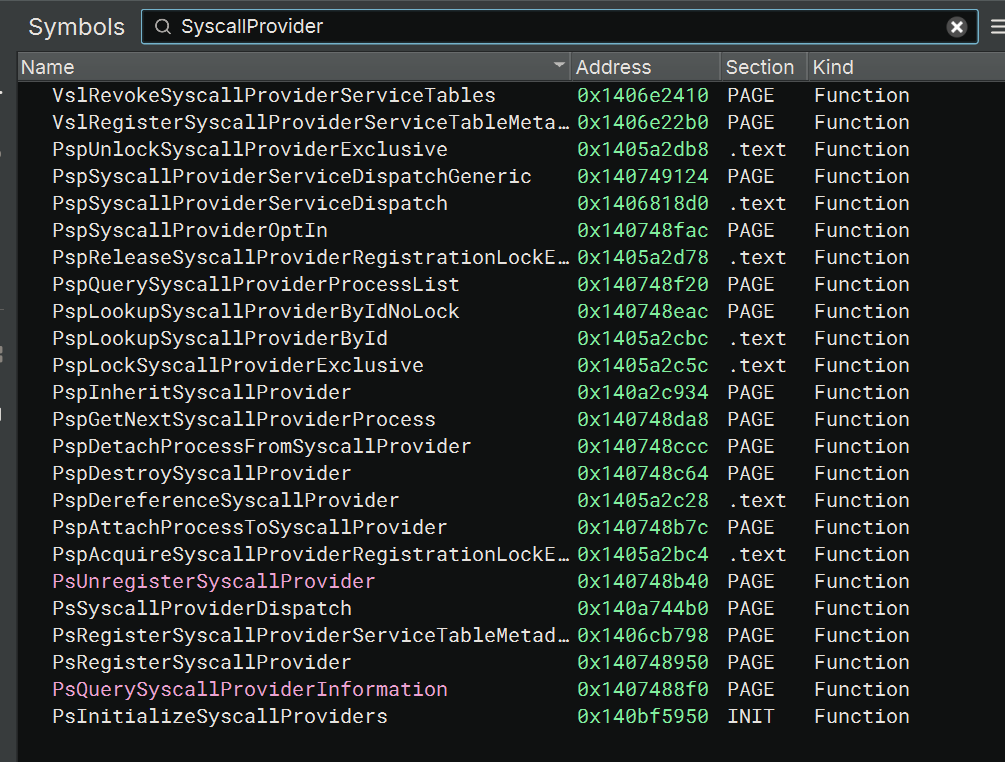
Taking a look at PsInitializeSyscallProviders:
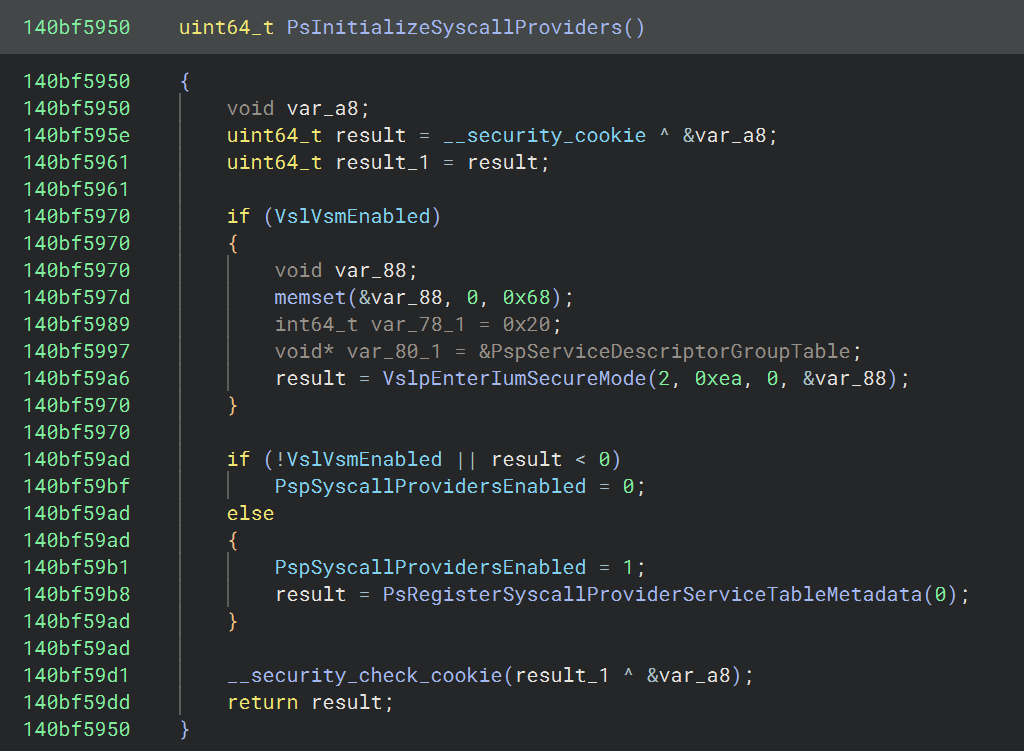
As you can see; it checks for Hyper-V. I actually paid for Windows 11 Pro (lol) when I came across this, before finding all of the above which enabled me to use Alt Syscalls. I’d like a refund :D!
Assuming Hyper-V is enabled and correct, it makes a call to the secure kernel passing in the control code 0xea.
VslpEnterIumSecureMode(2, 0xea, 0, &var_88);
So, I was curious - I decompiled the Secure Kernel, which shows:
The calls into the Secure Kernel relating to Alt Syscalls will cause a bug check. I’m no expert on the Secure Kernel, so again, I need to test this once I re-sort my Hyper-V VM, but it would appear to me that Microsoft have designed an API to use alt syscalls, whilst it may be for internal use only (i.e. Defender), I am speculating that this API could be made available to ELAM signed drivers of AntiVirus / EDR vendors.
Final comments
And thats about it! I hope you enjoyed the read! This is stable on my build, with no PatchGuard bug checks. If you have any questions, or recreate / improve on this, please let me know via email (fluxsec@proton.me), or at X - @0xfluxsec!
Ciao!

